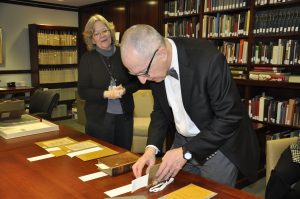
Last February we welcomed Smithsonian Secretary David J. Skorton to the Joseph F. Cullman 3rd Library in the National Museum of Natural History. On behalf of his wife Dr. Robin Davisson and himself, the Secretary was on a mission to select books for conservation as part of the Libraries’ Adopt-a-Book Program. Lilla Vekerdy, head of special collections, and Leslie Overstreet, curator of natural history rare books, displayed special treasures dating back to the 16th century from our collection. While we may have enticed him with too many selections, the Secretary ultimately chose three books:
- Slave Songs of the United States by William Francis Allen (1867): This historic collection was the first assortment of slave songs to appear in print, and was compiled by white Northerners who lived among the ex-slaves in the Sea Islands off the coast of South Carolina and Georgia as teachers and missionaries. The detailed table of contents indicates the geographical sources of the songs and the names of the contributors, and notes are attached to many of the songs.
- A New System of Domestic Cookery by Maria Rundell (1810): This book was the most famous and deservedly popular cookbook in England in the first half of the 19th century. First published anonymously “by a Lady” in 1806, and credited to Maria Eliza Rundell (1745-1817) only after her death, it stayed in print through more than 60 editions into the 1860s. It was these many editions that made the fortune of the book’s publisher, John Murray, which became one of the pre-eminent firms in London (publishing, for example, all of Charles Darwin’s works). Our copy is from the personal library of the Smithsonian Institution’s founder, James Smithson. The title page notes that the book cost “Seven Shillings and Sixpence in Boards,” meaning that it was sold with the printed pages sewn into a text-block with hard covers (but the buyer would still need to pay separately for a stronger and more permanent binding in leather). Smithson’s copy remains just as issued, in plain boards.
- Explicatio Tabularum Anatomicarum Bartholomaei Eustachii… by Bernardi Siegfried Albini (1744): One of the most important of all anatomical books, it includes the first specific treatise on the kidney, the first account of the Eustachian tube in the ear, the first description of the thoracic duct, and the Eustachian valve, as well as the first systematic study of teeth. The fine etchings illustrating the edition were the first eight in an intended series of forty-seven anatomical plates engraved by Giulio de’ Musi after drawings by Bartolomeo Eustachi and his relative, Pier Matteo Pini, an artist. These were prepared in 1552 to illustrate a projected book entitled De Dissensionibus ac Controversiis Anatomicis, the text of which was lost after Eustachi’s death in 1574. Had the full series of plates been published at the time of their completion, Eustachi would have ranked with Vesalius as a founder of modern anatomy. The long search for the missing plates culminated in their discovery in the hands of a descendant of Pier Matteo Pini and their publication as Tabulae Anatomicae (1714) by Giovanni Maria Lancisi, the physician of Pope Clement XI and a successor to Eustachi in the chair of anatomy at the Sapienza. The plates are strikingly modern, produced without the conventional sixteenth-century decorative accompaniments and framed on three sides by numbered rules providing coordinates by which any part of the image could be located. The images are generic figures, composites of many anatomical observations, and are mathematically as well as representationally exact.
 Many historic items in the Smithsonian Libraries rare book collection are becoming too brittle to handle and paper degradation means content is slipping away. One-third of our items require conservation if they are to remain available to future researchers. Our team of book conservators stabilizes and preserves our books, maintaining accessibility and preserving them for future generations. Adoptions and other gifts to the Smithsonian Libraries’ preservation department enable our experts to use the latest techniques to conserve, restore, and digitize these irreplaceable records.
Many historic items in the Smithsonian Libraries rare book collection are becoming too brittle to handle and paper degradation means content is slipping away. One-third of our items require conservation if they are to remain available to future researchers. Our team of book conservators stabilizes and preserves our books, maintaining accessibility and preserving them for future generations. Adoptions and other gifts to the Smithsonian Libraries’ preservation department enable our experts to use the latest techniques to conserve, restore, and digitize these irreplaceable records.
Many thanks to Dr. Robin Davisson and the Secretary for investing in our Adopt-a-Book Program!
All book adopters receive a bookplate added in their name to the book as well as a virtual bookplate in our online catalog. More information about the Libraries’ Adopt-a-Book Program.

Be First to Comment